Intel's Core i7 870 & i5 750, Lynnfield: Harder, Better, Faster Stronger
by Anand Lal Shimpi on September 8, 2009 12:00 AM EST- Posted in
- CPUs
New Heatsinks and Motherboards
LGA-1156 processors use a different heatsink than both LGA-1366 and LGA-775 chips.
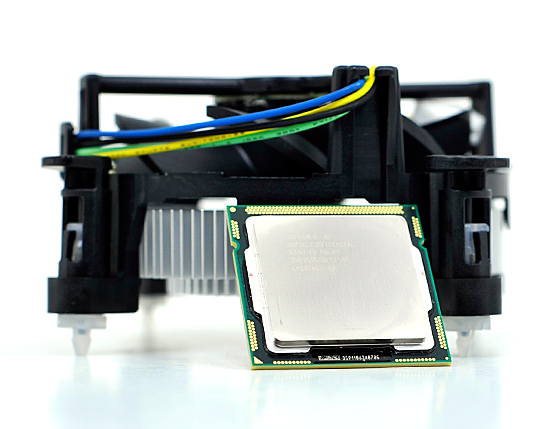
Lynnfield and its cooler
As the numbers would imply, the LGA-1156 heatsink has a larger footprint than LGA-775 but smaller than LGA-1366.
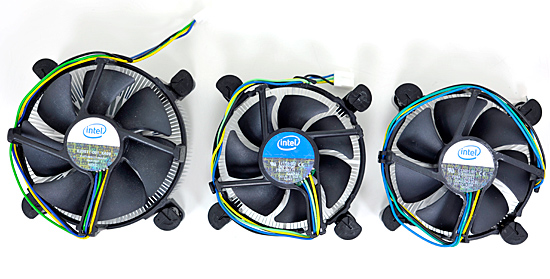
From Left to Right: Retail LGA-1366 Cooler, Retail LGA-1156 Cooler, Retail 45nm LGA-775 Cooler
The retail LGA-1156 is actually much closer to the 45nm LGA-775 retail cooler than the LGA-1366 retail HSF:
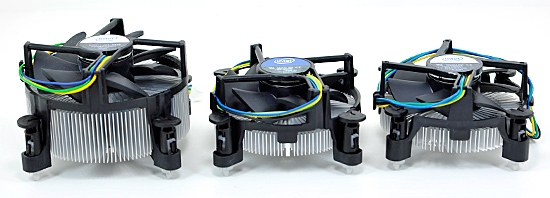
As you'll see later on in the article, the retail cooler isn't very good for heavy overclocking. Power users will want something a little bigger:
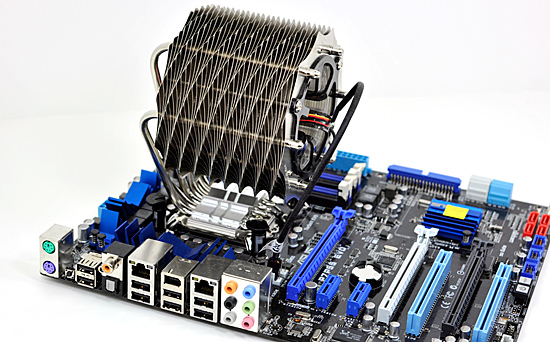
The Lynnfield/P55 launch is huge. Virtually every single motherboard manufacturer has a P55 board available. Prices range from ~$110 - $300 depending on the number of bells and whistles.

Gigabyte's ultra high end UD6 (left) and Gigabyte's lower end micro-ATX UD4 (right)
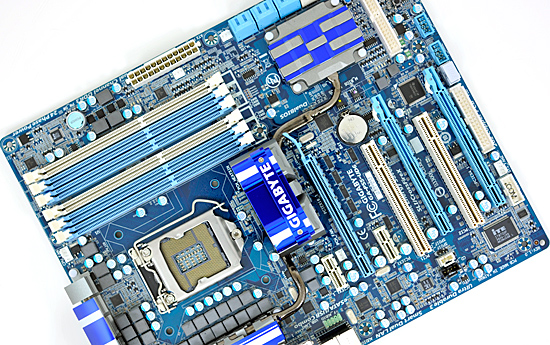
Gigabyte's high end UD6 comes with 6 DIMM slots like its X58 brethren.
Micro-ATX is increasing in popularity and we actually have some good options this time if you're trying to build a smaller Lynnfield system. Combined with Lynnfield's excellent idle power (the lowest of any quad-core we've ever tested), this could make for an unusually potent HTPC.
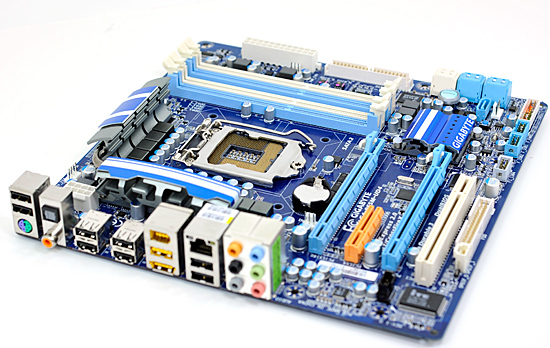
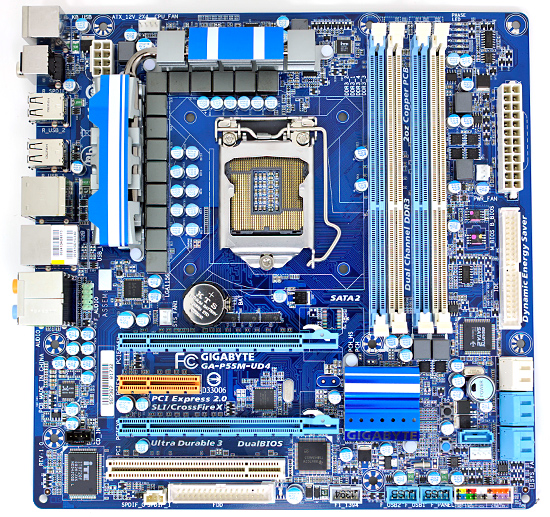
A closer look at Gigabyte's micro-ATX P55M-UD4
The only thing we're really missing is a good mini-ITX Lynnfield board. But perhaps the manufacturers will wait until we have on-package graphics before going down that route...
One More Time: New H55 Boards Next Year
As I subtley implied at the end of the last section, Intel is bringing on-package graphics to Nehalem starting in Q4 of this year:
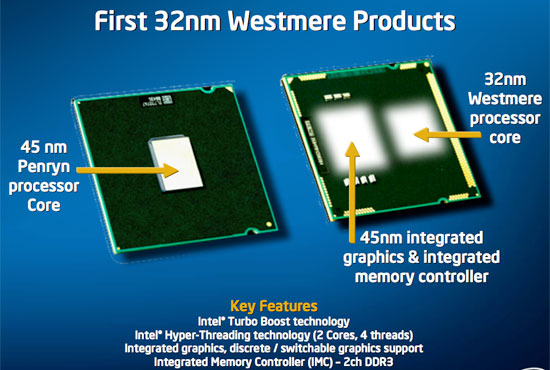
The 32nm Nehalem shrink, codenamed Westmere, will be available with a 45nm Intel graphics core on the processor's package. This graphics core is an evolution of what's currently in the G45 chipset and not Larrabee (although eventually that will change). From what I've heard, this is actually going to be Intel's first reasonably good integrated graphics core.
With the graphics on-package, there needs to be an interface from the processor socket to video output located on the motherboard. As you can see from the P55 motherboards that are launching today: none of them have this video out. Granted there aren't any CPUs out to take advantage of it either.

No DVI/HDMI/VGA out...yet
Early next year (or maybe even late this year) we'll see a new breed of LGA-1156 motherboards with video output, designed for use with these Westmere IGP parts. Rumor has it that these motherboards will use Intel's H55 chipset.
Lynnfield early adopters need not worry, 32nm quad-core processors won't be out for at least a year.










343 Comments
View All Comments
Shadowmaster625 - Tuesday, September 8, 2009 - link
Intel releases yet another new socket type, offering negligible performance enhancements vs socket 775. Soon they will obsolete another socket type still in use. And this is a good thing? I'm still dealing with the fallout from the socket 478...DJMiggy - Tuesday, September 8, 2009 - link
Thanks! Some good info! Now to decide what to do...Rabman - Tuesday, September 8, 2009 - link
Full disclusre -- I work for AMD, my comments are my own and do not reflect my employer, etc.A clarification on Windows 7's Core Parking feature -- it doesn't actually "[look] at the performance penalty from migrating a thread from one core to another". Rather, Core Parking was designed as a power saving feature for multi-core server machines, and is only enabled on Windows 7 client SKUs where HT is present (I won't get into specifics as to why this decision was made). The side benefit for processors with HT is that the hyperthreads can be parked so the Windows scheduler will spread threads across the "real" cores first, resulting in better performance characteristics.
rbbot - Tuesday, September 8, 2009 - link
That implies that it would have a negative effect on the chances of turbo mode engaging. On other OS, pure random chance would sometimes assign a waking thread to the hyper-core of the one already executing at full pelt. However, this means that on Windows 7, core parking prevents this happening and always wakes a 2nd core for the 2nd thread.puffpio - Tuesday, September 8, 2009 - link
If you disable turbo mode, will the individual cores still power down when unused?Take the 860 for example. With turbo mode enabled you get these overclocked speeds:
3C/4C Active: 3.54GHz
2C Active: 3.85GHz
1C Active: 4.00GHz
but with turbo mode disabled you get 3.99GHz at 1/2/3/4 cores active.
If the cores are still able to be powered down w/ turbo mode disabled, it would seem that would give you the best performance at any core activity level.
Comdrpopnfresh - Tuesday, September 8, 2009 - link
Specifically; power consumption, efficiency, and productivity/performance. On the consumer scale though- obviously with single-cpu boards benches geared towards commercial use would be droll.AFUMCBill - Tuesday, September 8, 2009 - link
Great Review.You mentioned the rising popularity of the uATX platform.
I would guess this is related to the rising popularity of laptops.
Except you can't find anything close to the performance of a Core i7 or i5 processor in a laptop form factor at anything remotely resembling a reasonable price - as in thousands and thousands of dollars extra. So people are headed to the uATX platform and the small(er) LAN party type boxes to get mobile performace. In my case I would like to be able to load high bitrate (25 Mbps and up) MPEG2 and MPEG4 footage into my video editor and have at it. My Q6600 handles the MPEG2 fine, but not the MPEG4 (AVCHD).
Found the Core i7 860 available at MicroCenter for $229.99 USD.
For me to make the buy, the only thing that is missing is USB 3.0.
Next year is looking good...and prices are likely to be even lower then :-)
Peroxyde - Tuesday, September 8, 2009 - link
Just checked at Newegg. Is there any error on the price? The newer and more performance i5 750 costs $209. The Q9550 cost $219. That sounds illogical.AFUMCBill - Tuesday, September 8, 2009 - link
I think it's called having old stock that was purchased before the new announcements. Obviously the folks they are going to be selling to are ones who are updating the processor in an older 775 socket motherboard based system - which with the new announcements are now rapidly receding into the past.C'DaleRider - Tuesday, September 8, 2009 - link
Sucks to have to depend on Newegg for buying, esp. considering what MicroCenter is doing. $199 for the i7 920 while Newegg gouges at $279, or the i5 750 for $179.Newegg long ago ceased being the place for the best prices.